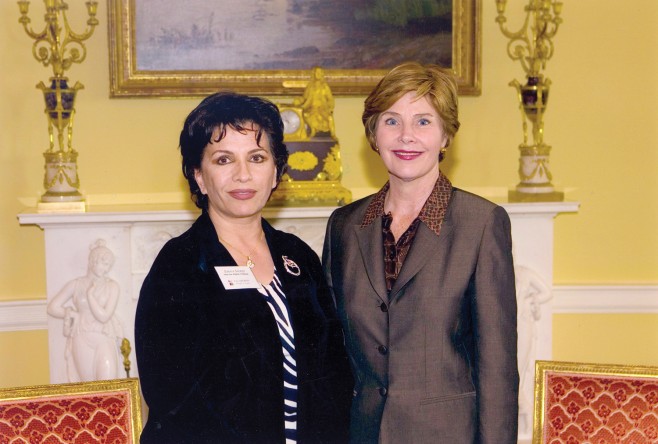
Suraya Sadeed, MA ’12 (conflict transformation), the founder and executive director of Help the Afghan Children, was a guest of First Lady Laura Bush at the White House in 2005, returning in 2006 as a participant at an event hosted by both Laura and George Bush. (Photo courtesy of Suraya Sadeed)
Simin Wahdat is the tenth Afghan-born person – four being women – to enroll as a graduate student in EMU’s Center for Justice and Peacebuilding (CJP).
Five of these 10 Afghans belong to an extended family that believes strongly in education and public service, for both women and men.
Simin is the cousin of two sisters who have earned master’s degrees through CJP: Nilofar Sakhi, MA ’07, and Farishta Sakhi, MA ’10. They are married, respectively, to Farshid Hakimyar, who attended the 2007 Summer Peacebuilding Institute and then returned to complete a master’s degree (projected graduation date of fall 2014), and Ramin Nouroozi, MA ’10, now working in Afghanistan on a Habitat program.
Simin, Nilofar and Farishta have all been involved with civil society organizations that support equal rights for women. Nilofar, for example, founded and directed for years the Women’s Activities and Social Services Association of Afghanistan, before coming to EMU. Farishta succeeded Nilofar at the helm of this organization, but now works in Afghanistan’s Ministry of Foreign Affairs.
The fourth Afghan-born woman, Suraya Sadeed, MA ’12, was well-known before she chose to complete a master’s degree through CJP. In 2005, she was honored by Laura Bush at the White House (returning in 2006) and invited to the Oprah show for the second time (garnering Oprah funds for opening seven schools in Afghanistan). She has been featured in Reader’s Digest, People magazine and the Los Angeles Times magazine.
In print and online, EMU has documented her 20 years of efforts to build schools, supply relief to refugees, and advocate for the well-being of all of Afghanistan’s children, but particularly for girls. (Check these stories out online by typing “Peacebuilder Sadeed” in a search engine.)
Sadeed’s 2011 book, Forbidden Lessons in a Kabul Guesthouse, is highly recommended for both its readability and content by Doug Hostetter ’66, director of Mennonite Central Committee’s United Nations Office.
“She’s a saint in my eyes,” Hostetter says. “I’ve personally seen how she reacts in difficult and dangerous situations, but persists in doing what she thinks needs to be done to help her people.”
In the December 2013 newsletter published by Help the Afghan Children, Sadeed reported on lessons occurring in HTAC’s 38 schools serving 29,500 students. In addition to teaching literacy, basic math, and computer skills, Sadeed’s educators are piloting a peace education curriculum informed by her CJP studies and approved by Afghanistan’s Ministry of Education.
Like Simin, Sadeed is acutely aware that the 2014 elections might mark some kind of turning point in Afghan society. As a result, personnel in her HTAC schools have interacted with 3,000 local leaders to discuss ways to raise awareness about the electoral rights of each and every citizen, especially those of women.
Sadeed has no illusions about the ease of changing long-held beliefs and practices: “The best school programs alone will not produce lasting change unless parents and entire communities embrace peaceful, everyday living – where women are protected, understand their rights and participate in local decisions.”
– Bonnie Price Lofton